Abstract
Three hundred and ninety one male employees aged 35-65 in a Swedish pulp and paper company were followed up for 22 years; 151 deaths were recorded by 31 December 1983. On the basis of data from 1961, indices for job decision latitude, job support, and other work related psychosocial factors were constructed as were five indices for non-work related social network factors. All indices were checked by life table analysis in respect of mortality. Job decision latitude and a combined index for job decision latitude and job support showed significant associations with mortality. These two indices were investigated by multivariate analysis with scale for evaluation of neuroticism and known somatic risk factors such as smoking, cholesterol, and systolic and diastolic blood pressure. Age, educational level, occupational status, physically heavy work, and general health state were also included in the multivariate analysis. Age, systolic blood pressure, the combined index for job decision latitude and job support, smoking, and neuroticism were shown to be independent predictors of mortality.
Full text
PDF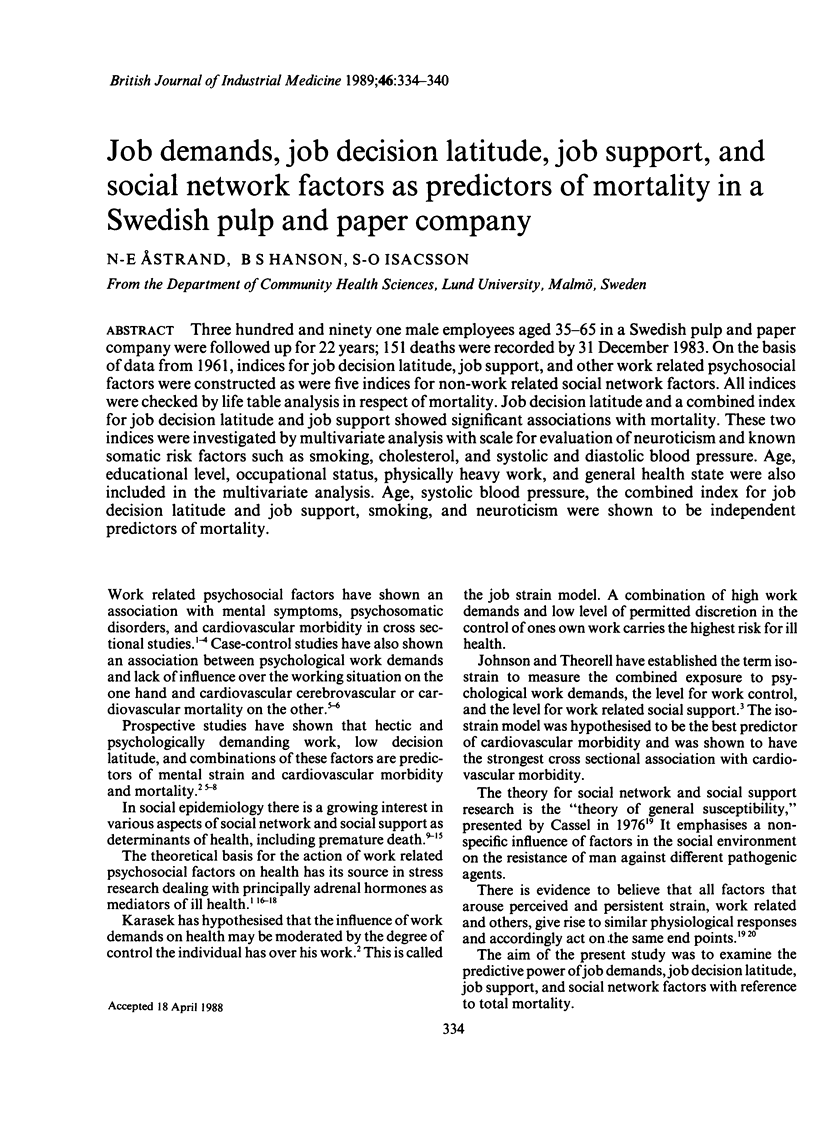
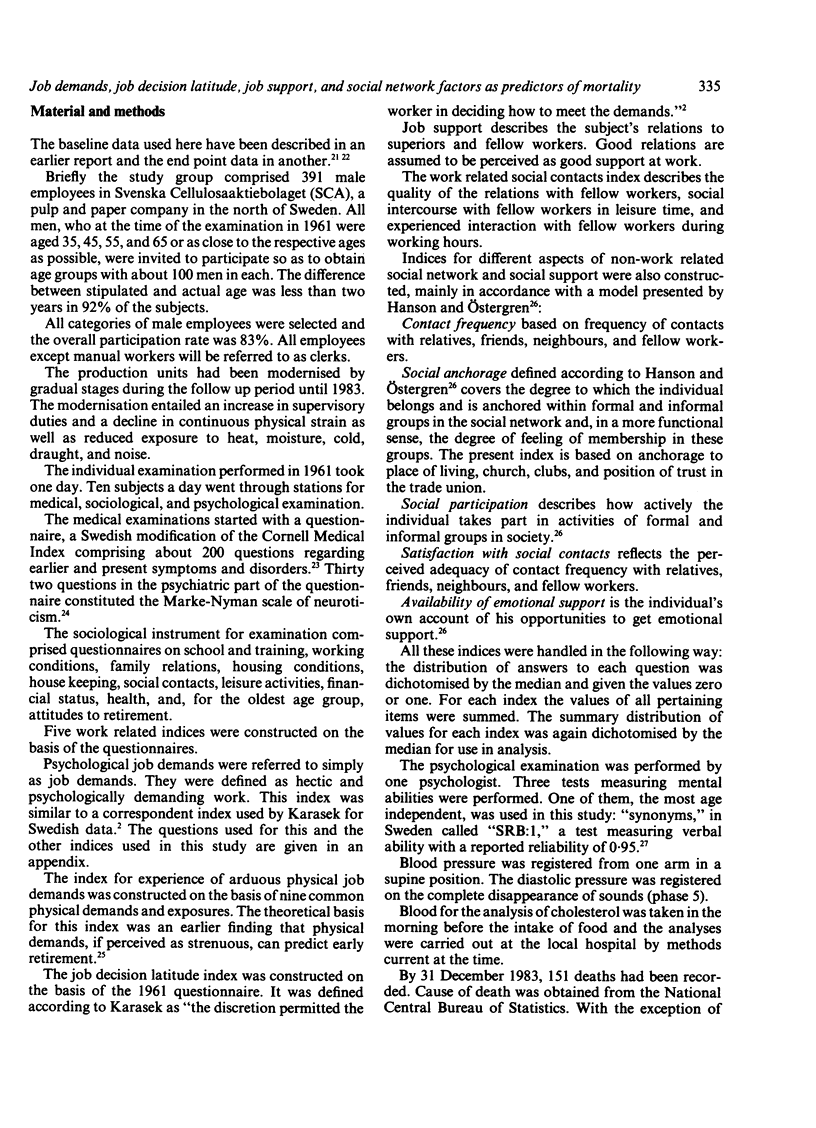
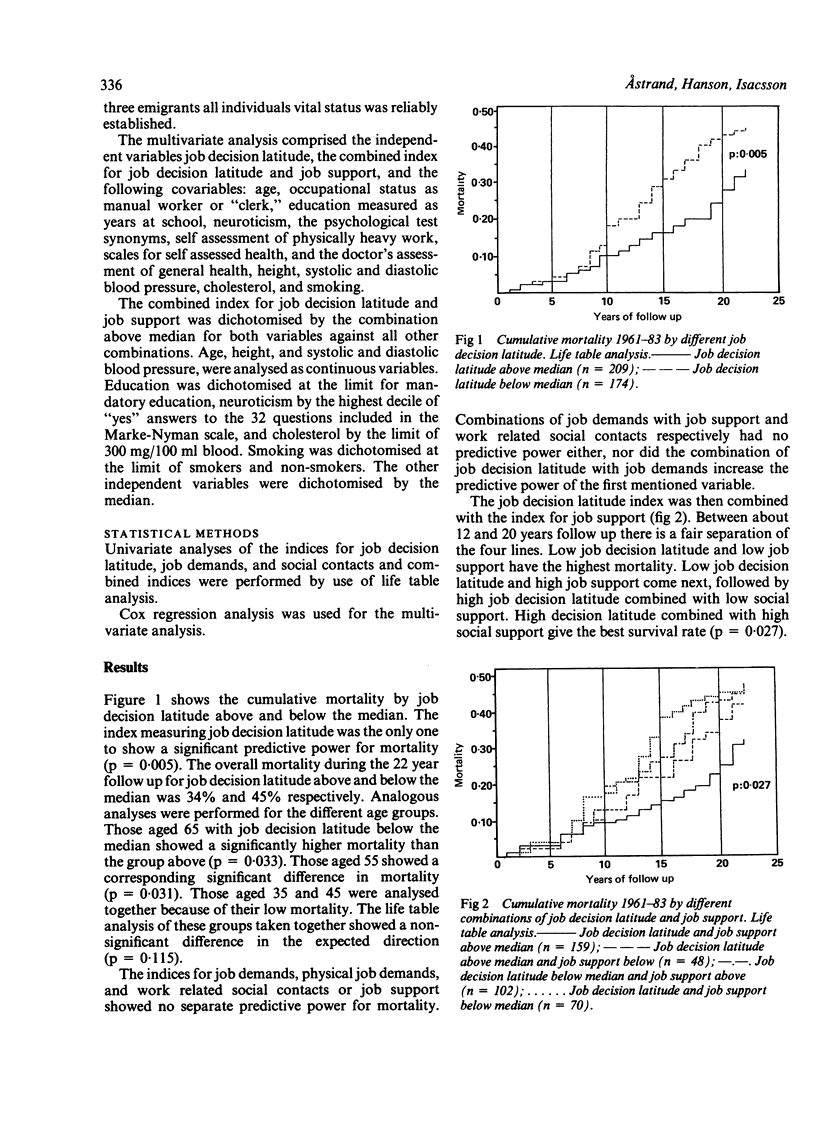
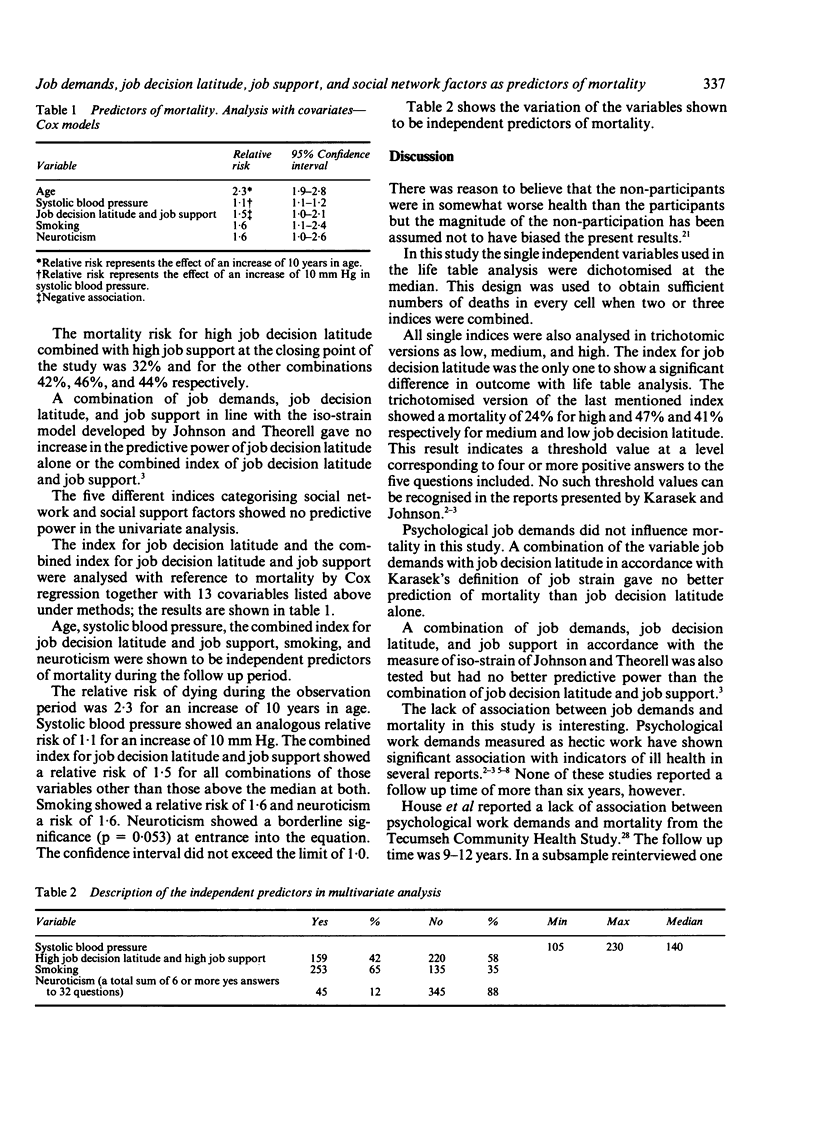
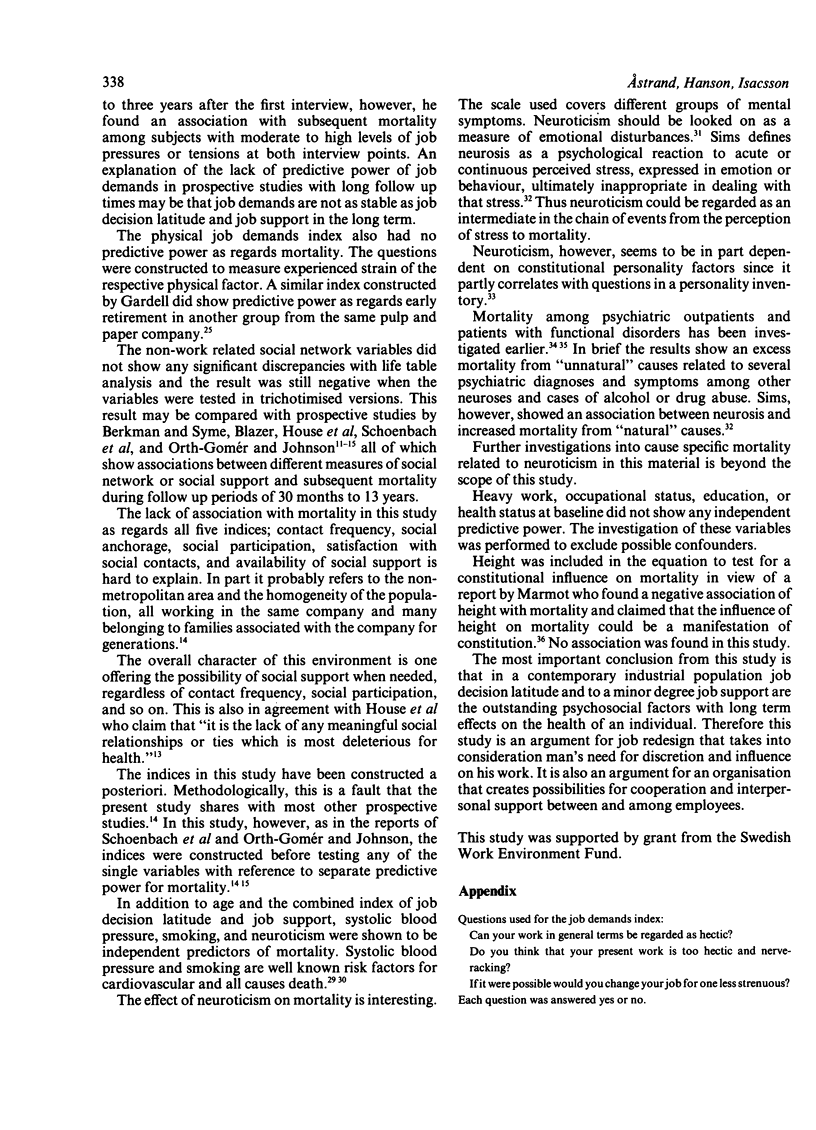
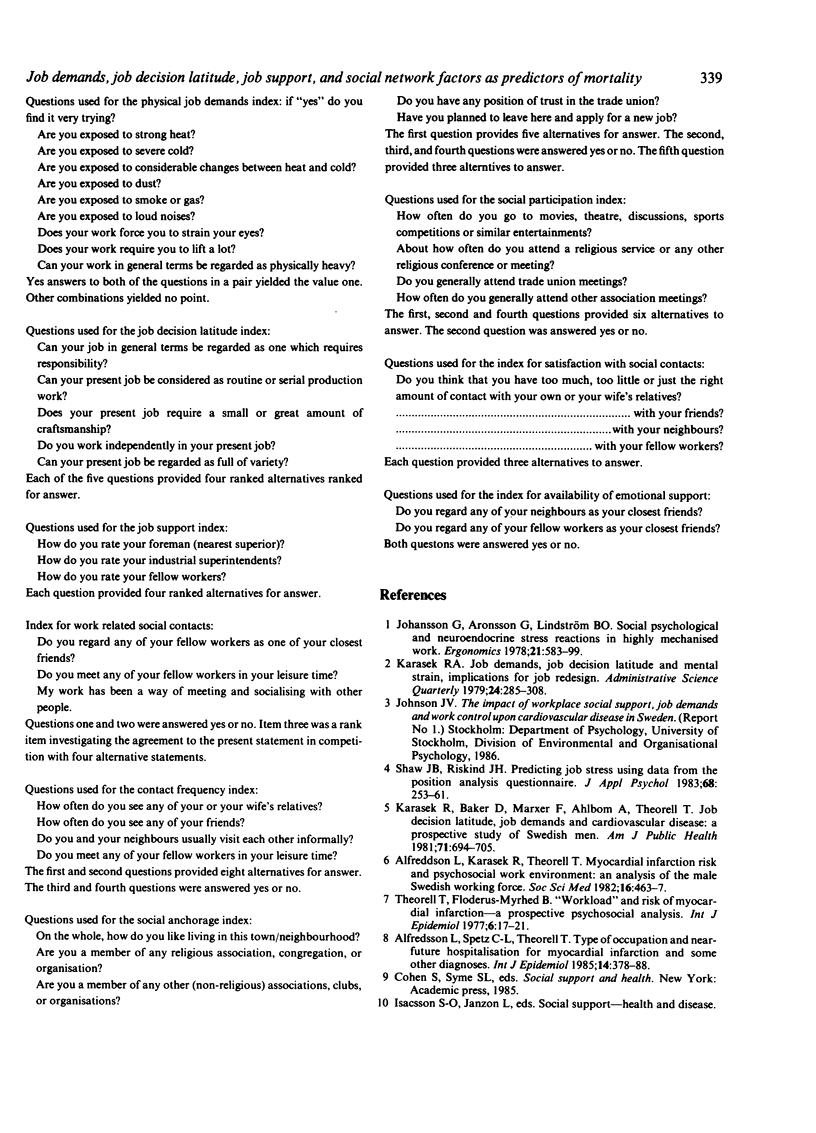
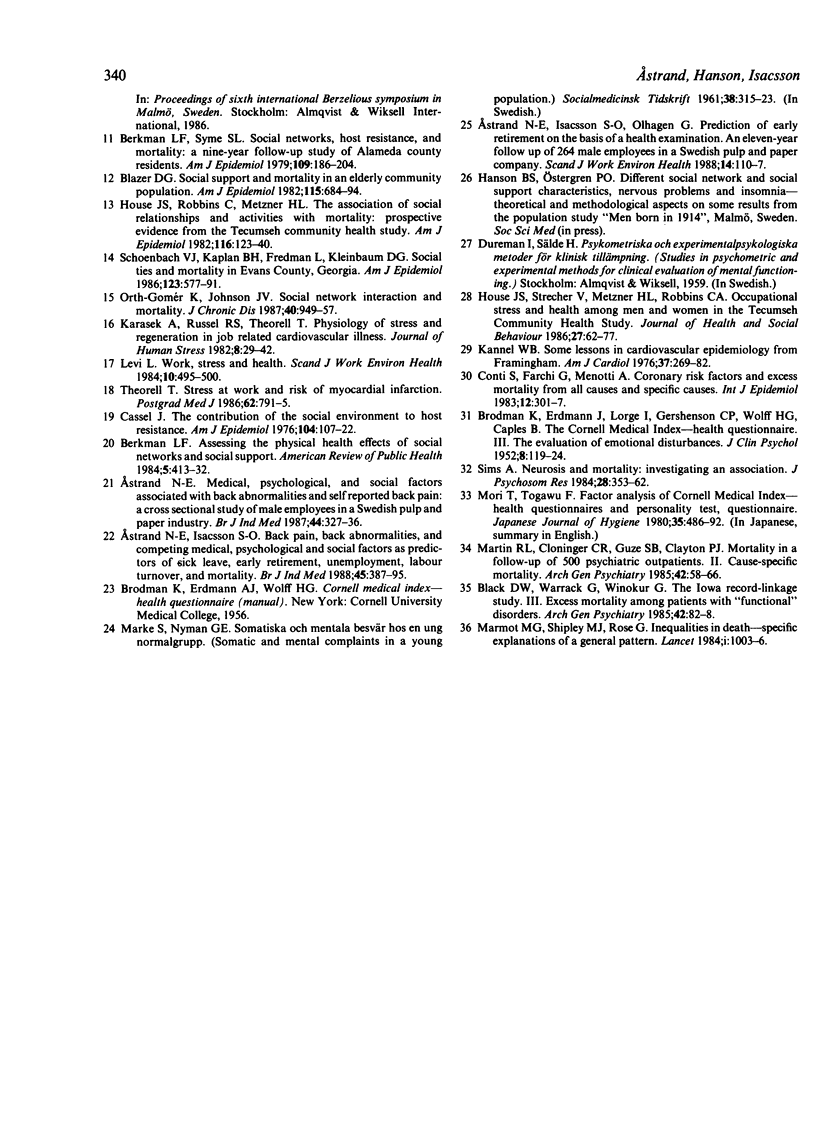
Selected References
These references are in PubMed. This may not be the complete list of references from this article.
- Alfredsson L., Karasek R., Theorell T. Myocardial infarction risk and psychosocial work environment: an analysis of the male Swedish working force. Soc Sci Med. 1982;16(4):463–467. doi: 10.1016/0277-9536(82)90054-5. [DOI] [PubMed] [Google Scholar]
- Alfredsson L., Spetz C. L., Theorell T. Type of occupation and near-future hospitalization for myocardial infarction and some other diagnoses. Int J Epidemiol. 1985 Sep;14(3):378–388. doi: 10.1093/ije/14.3.378. [DOI] [PubMed] [Google Scholar]
- Astrand N. E., Isacsson S. O. Back pain, back abnormalities, and competing medical, psychological, and social factors as predictors of sick leave, early retirement, unemployment, labour turnover and mortality: a 22 year follow up of male employees in a Swedish pulp and paper company. Br J Ind Med. 1988 Jun;45(6):387–395. doi: 10.1136/oem.45.6.387. [DOI] [PMC free article] [PubMed] [Google Scholar]
- Astrand N. E., Isacsson S. O., Olhagen G. O. Prediction of early retirement on the basis of a health examination. An 11-year follow-up of 264 male employees in a Swedish pulp and paper company. Scand J Work Environ Health. 1988 Apr;14(2):110–117. doi: 10.5271/sjweh.1948. [DOI] [PubMed] [Google Scholar]
- Astrand N. E. Medical, psychological, and social factors associated with back abnormalities and self reported back pain: a cross sectional study of male employees in a Swedish pulp and paper industry. Br J Ind Med. 1987 May;44(5):327–336. doi: 10.1136/oem.44.5.327. [DOI] [PMC free article] [PubMed] [Google Scholar]
- Berkman L. F. Assessing the physical health effects of social networks and social support. Annu Rev Public Health. 1984;5:413–432. doi: 10.1146/annurev.pu.05.050184.002213. [DOI] [PubMed] [Google Scholar]
- Berkman L. F., Syme S. L. Social networks, host resistance, and mortality: a nine-year follow-up study of Alameda County residents. Am J Epidemiol. 1979 Feb;109(2):186–204. doi: 10.1093/oxfordjournals.aje.a112674. [DOI] [PubMed] [Google Scholar]
- Black D. W., Warrack G., Winokur G. The Iowa record-linkage study. III. Excess mortality among patients with 'functional' disorders. Arch Gen Psychiatry. 1985 Jan;42(1):82–88. doi: 10.1001/archpsyc.1985.01790240084009. [DOI] [PubMed] [Google Scholar]
- Blazer D. G. Social support and mortality in an elderly community population. Am J Epidemiol. 1982 May;115(5):684–694. doi: 10.1093/oxfordjournals.aje.a113351. [DOI] [PubMed] [Google Scholar]
- Cassel J. The contribution of the social environment to host resistance: the Fourth Wade Hampton Frost Lecture. Am J Epidemiol. 1976 Aug;104(2):107–123. doi: 10.1093/oxfordjournals.aje.a112281. [DOI] [PubMed] [Google Scholar]
- Conti S., Farchi G., Menotti A. Coronary risk factors and excess mortality from all causes and specific causes. Int J Epidemiol. 1983 Sep;12(3):301–307. doi: 10.1093/ije/12.3.301. [DOI] [PubMed] [Google Scholar]
- House J. S., Robbins C., Metzner H. L. The association of social relationships and activities with mortality: prospective evidence from the Tecumseh Community Health Study. Am J Epidemiol. 1982 Jul;116(1):123–140. doi: 10.1093/oxfordjournals.aje.a113387. [DOI] [PubMed] [Google Scholar]
- House J. S., Strecher V., Metzner H. L., Robbins C. A. Occupational stress and health among men and women in the Tecumseh Community Health Study. J Health Soc Behav. 1986 Mar;27(1):62–77. [PubMed] [Google Scholar]
- Johansson G., Aronsson G., Lindström B. O. Social psychological and neuroendocrine stress reactions in highly mechanised work. Ergonomics. 1978 Aug;21(8):583–599. doi: 10.1080/00140137808931761. [DOI] [PubMed] [Google Scholar]
- Kannel W. B. Some lessons in cardiovascular epidemiology from Framingham. Am J Cardiol. 1976 Feb;37(2):269–282. doi: 10.1016/0002-9149(76)90323-4. [DOI] [PubMed] [Google Scholar]
- Levi L. Work, stress and health. Scand J Work Environ Health. 1984 Dec;10(6 Spec No):495–500. doi: 10.5271/sjweh.2295. [DOI] [PubMed] [Google Scholar]
- Marmot M. G., Shipley M. J., Rose G. Inequalities in death--specific explanations of a general pattern? Lancet. 1984 May 5;1(8384):1003–1006. doi: 10.1016/s0140-6736(84)92337-7. [DOI] [PubMed] [Google Scholar]
- Martin R. L., Cloninger C. R., Guze S. B., Clayton P. J. Mortality in a follow-up of 500 psychiatric outpatients. II. Cause-specific mortality. Arch Gen Psychiatry. 1985 Jan;42(1):58–66. doi: 10.1001/archpsyc.1985.01790240060006. [DOI] [PubMed] [Google Scholar]
- Mori T., Togawa K. [Factor analysis of Cornell Medical Index-Health Questionnaires and personality test questionnaires (author's transl)]. Nihon Eiseigaku Zasshi. 1980 Jun;35(2):486–492. doi: 10.1265/jjh.35.486. [DOI] [PubMed] [Google Scholar]
- Orth-Gomér K., Johnson J. V. Social network interaction and mortality. A six year follow-up study of a random sample of the Swedish population. J Chronic Dis. 1987;40(10):949–957. doi: 10.1016/0021-9681(87)90145-7. [DOI] [PubMed] [Google Scholar]
- Schoenbach V. J., Kaplan B. H., Fredman L., Kleinbaum D. G. Social ties and mortality in Evans County, Georgia. Am J Epidemiol. 1986 Apr;123(4):577–591. doi: 10.1093/oxfordjournals.aje.a114278. [DOI] [PubMed] [Google Scholar]
- Shaw J. B., Riskind J. H. Predicting job stress using data from the Position Analysis Questionnaire. J Appl Psychol. 1983 May;68(2):253–261. [PubMed] [Google Scholar]
- Sims A. Neurosis and mortality: investigating an association. J Psychosom Res. 1984;28(5):353–362. doi: 10.1016/0022-3999(84)90065-5. [DOI] [PubMed] [Google Scholar]
- Theorell T., Floderus-Myrhed B. 'Workload' and risk of myocardial infarction--a prospective psychosocial analysis. Int J Epidemiol. 1977 Mar;6(1):17–21. doi: 10.1093/ije/6.1.17. [DOI] [PubMed] [Google Scholar]
- Theorell T. Stress at work and risk of myocardial infarction. Postgrad Med J. 1986 Aug;62(730):791–795. doi: 10.1136/pgmj.62.730.791. [DOI] [PMC free article] [PubMed] [Google Scholar]


